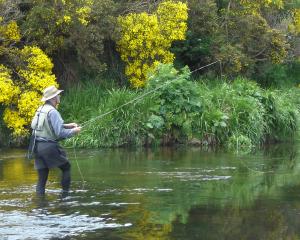Things are looking even better for the fishing this weekend. Rivers have dropped considerably this week and cleared, too, as some were still peat stained last weekend.
Provided the weather gremlins do not creep in and spoil things, the decision of where to fish is going to be difficult, as everything looks good. We should not forget that although the rivers are good, some warm weather will bring out the cicadas on the tussock lakes and provided there are not too many of them, some great sport can be had.
Cicada fishing can often be disappointing; there can be cicadas everywhere yet nothing rises to them. One explanation is that when trout become gorged, they can stop feeding for a couple of days.
So cicada fishing is usually the best when the cicadas first begin to hatch and when the period of emergence is past its peak. At both times there will be fewer cicadas on the water than it takes to fill up the trout, so they will take any that they see, including yours and mine.
I was talking to some fly fishers the other day about trout often being difficult to hook even when they have risen to the artificial cicada. There are a couple of options that I know of to remedy this. This first one was told to me by Monty Wright a few years ago, and Monty is always worth listening to on matters piscatorial.
His approach is not to strike until the line draws away. I remember trying this for the first time and how much self-control it took not to strike at the rise. On the previous outing I had risen 15 trout and landed three, so I was desperate to make amends, even if it did mean exercising self-control. It was worth the effort, as I landed five trout for six rises.
The other tactic is not to fish a cicada at all. One day on Lake Onslow after missing a few on cicada, I switched to a coch-y-bondhu and did not miss a fish for the rest of the day. The result, from memory, was about 10 good fish, as it was not long after Onslow was raised in the late 1980s.
The temptation may be even greater to go to the Mataura, as I have fished it only twice this season. From now until the end of the season, this river can provide some of the best fishing in the South, as long as you enjoy casting small imitative fly patterns at an endless parade of finicky trout.
If the weather is calm, there is usually a fall of spinners in the morning before the day gets too warm. Then the nymph takes over or, if it is cool, there may be a sparse hatch of duns. And if neither of these occur, there will be fish to be spotted cruising the shallows feeding on cased caddis.
- Mike Weddell
RIVER AND LAKE CONDITIONS
River and Lake conditions are supplied by Fish and Game Otago with information from the Otago Regional Council received at 9am yesterday.-
General situation: Unsettled weather has resulted in a real mixed bag of river conditions throughout the region. Many rivers in the Southern Lakes are dropping and clearing, most North Otago coastal streams are at medium levels and clear, and some South Otago streams are rising. The large Central Otago irrigation dams are clear and in good order. In some areas, trout have been rising to cicadas on warm days. Showers are predicted for much of Otago this weekend.
North Otago: The Kakanui, Shag and Waikouaiti rivers are at medium levels and clear. The Hakataramea and Maerewhenua are dropping and clearing. The Waitaki River is dropping and discoloured. The Ahuriri is discoloured and rising again, and the Waitaki Lakes remain discoloured.
Southern Lakes: The larger rivers such as the Kawarau, Dart and Matukituki have had another large fresh and are dropping and clearing. There will be dirty water in the lakes near river delta areas. Smaller streams such as the Greenstone and Hunter will clear quickest. The controlled fishery on the Greenstone starts on 1 February. Go online to the Otago F&G website for more information.
Central Otago: The larger central irrigation dams are worth investigating on hot days with large dry flies. Manorburn has already been producing 1-2kg rainbows on cicada patterns during fine periods. Hopefully, trout will start to rising to cicadas on Onslow, Poolburn and Loganburn soon. The Manuherikia and Lindis are low and clear.
Taieri catchment: The upper Taieri River has received another fresh and is dropping and clearing. Trout in the upper reaches have been feeding on damsel flies and may start to target cicadas soon. The lower and middle reaches remain stable and clear.
Southwest Otago: The lower Clutha is still high and discoloured. The Pomahaka and Waipahi are rising after receiving rain in the head waters. Congratulations to the Balclutha anglers who won the Williams Fishing Competition on the Pomahaka last weekend. The average length of the trout caught was about 50cm and most of the fish were landed between Tapanui and Burkes Ford. No sea-run trout were caught, but some have been reported in the upper Pomahaka.
WATERWAY - WATER LEVEL/CONDITION
• Kakanui River - Medium, steady
• Shag River - Medium, steady
• Taieri River at Canadian Flat - Medium, dropping and clearing
• Taieri River at Outram - Medium, steady
• Pomahaka River - Medium, rising
• Waipahi River - Medium, rising
• Clutha River at Balclutha - High, discoloured
• Clutha River at Cardrona - Medium, rising
• Hawea River - High, clear
• Lake Onslow - Medium, clear
• Lake Dunstan - Medium, discoloured in Kawarau Arm
• Lake Hawea - High, discoloured near river deltas
• Lake Mahinerangi - High, clear
• Lake Wanaka - High, discoloured near river deltas
• Lake Wakatipu - High, discoloured near river deltas


